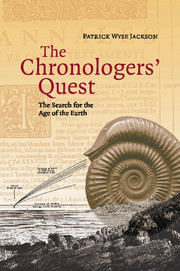Book contents
- Frontmatter
- Contents
- List of illustrations
- List of tables
- Preface
- Acknowledgements
- 1 The ancients: early chronologies
- 2 Biblical calculations
- 3 Models of Aristotelian infinity and sacred theories of the Earth
- 4 Falling stones, salty oceans, and evaporating waters: early empirical measurements of the age of the Earth
- 5 Thinking in layers: early ideas in stratigraphy
- 6 An infinite and cyclical Earth and religious orthodoxy
- 7 The cooling Earth
- 8 Stratigraphical laws, uniformitarianism and the development of the geological column
- 9 ‘Formed stones’ and their subsequent role in biostratigraphy and evolutionary theory
- 10 The hour-glass of accumulated or denuded sediments
- 11 Thermodynamics and the cooling Earth revisited
- 12 Oceanic salination reconsidered
- 13 Radioactivity: invisible geochronometers
- 14 The Universal problem and Duck Soup
- Bibliography
- Index
12 - Oceanic salination reconsidered
Published online by Cambridge University Press: 02 December 2009
- Frontmatter
- Contents
- List of illustrations
- List of tables
- Preface
- Acknowledgements
- 1 The ancients: early chronologies
- 2 Biblical calculations
- 3 Models of Aristotelian infinity and sacred theories of the Earth
- 4 Falling stones, salty oceans, and evaporating waters: early empirical measurements of the age of the Earth
- 5 Thinking in layers: early ideas in stratigraphy
- 6 An infinite and cyclical Earth and religious orthodoxy
- 7 The cooling Earth
- 8 Stratigraphical laws, uniformitarianism and the development of the geological column
- 9 ‘Formed stones’ and their subsequent role in biostratigraphy and evolutionary theory
- 10 The hour-glass of accumulated or denuded sediments
- 11 Thermodynamics and the cooling Earth revisited
- 12 Oceanic salination reconsidered
- 13 Radioactivity: invisible geochronometers
- 14 The Universal problem and Duck Soup
- Bibliography
- Index
Summary
Sometime in July 1897 two men boarded the yacht Marling-Spike carrying with them a range of tubes, bottles and nets and other collecting paraphernalia. They set sail from the Bullock Harbour, close to the small picturesque village of Dalkey, ten miles south of Dublin, and steered the yacht southwards into Killiney Bay. They would have passed through Dalkey Sound with the low Dalkey Island on their left, on which was built a Martello tower. This robust, circular construction was just one of many around the Irish coastline built in the first decades of the nineteenth century as a first line of defence against a Napoleonic invasion. The advance never came and today the tower offers scant shelter against the frequent winter storms for the feral goats that eke out a precarious existence there.
On its landward side, Killiney Bay is dominated by a granite crag, topped with a monumental folly that overlooks the fine housing belonging to professional gentlemen and their families. Living on roads with names such as Sorrento Terrace and Vico Road, many are unaware of the similarity of their view to that at the Bay of Naples. The only geological feature missing is the dominant volcano; here the residents can reflect instead on the nature of the distant Great Sugar Loaf Mountain to the southwest. This is a mere pimple when compared with Vesuvius, and is not even volcanic in origin: composed of Cambrian quartzites, it has weathered to a fine conical shape, which has often been misinterpreted as a volcano. Back in 1897, a black trail of commuters would have walked daily down the hill to the railway, where they would have caught the northbound train to Dublin that began its journey from the holiday resort of Bray to the south.
- Type
- Chapter
- Information
- The Chronologers' QuestThe Search for the Age of the Earth, pp. 210 - 226Publisher: Cambridge University PressPrint publication year: 2006



